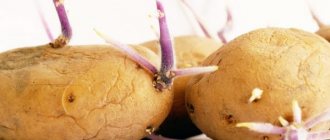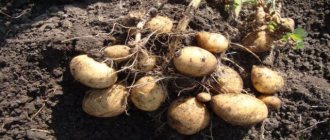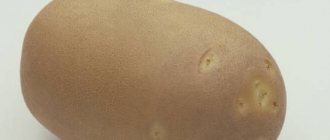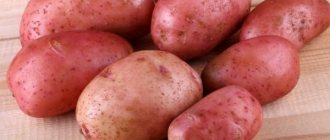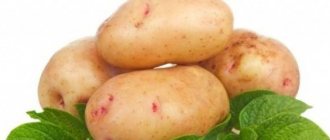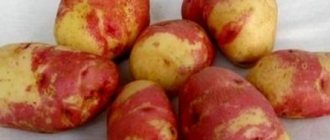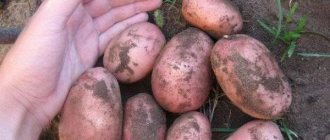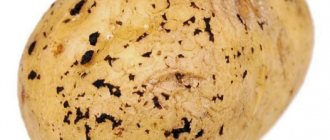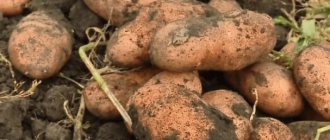Potatoes “Krasa” are a mid-late variety that is famous for its amazing taste. The peculiarity of such potatoes is that they boil quickly, but when used in first courses, they retain their benefits. To plant a variety in your garden, you need to know the rules, following which will allow you to get a high-quality harvest and a large number of beautiful fruits.
Characteristics of the variety
The ripening period for Krasa potatoes ranges from 80 to 100 days, which is why it is considered a medium-late variety. They are grown in all regions of Russia. The Ilyinsky variety can be characterized by its excellent taste and good presentation. These are table potatoes, and when planted, you can get a high yield. It tolerates drought and various mechanical damage without difficulty, and exhibits increased resistance to various diseases and pests.
It is best to plant potatoes in light soil with excellent breathability. The variety grows as strong, erect bushes with a strong and massive stem part. Bushes with green leaves and medium-sized corollas. Each nest produces 6-8 tubers.
Detailed characteristics are shown in the table below:
| Criterion | Characteristic |
| Adaptation | perfectly adapts to soil and climate, bears fruit consistently |
| Maturation period | 80-100 days |
| Starch content | 15-19% |
| Weight of marketable tubers | 250-300 g |
| Number of tubers in a bush | 6-8 |
| Productivity | 400-450 c/ha |
| Keeping quality | 95% |
| Consumer qualities | good taste, great for baking and frying |
| Peel | dense, red |
| Pulp | light yellow |
| Resistance to pests and diseases | the predominant variety is highly resistant to diseases and pests |
| Features of cultivation | standard agricultural technology |
| Where is it preferable to plant | in any region of Russia |
Description of the potato variety Krasa
The vegetable was included in the state register of breeding achievements in 2017. Recommended for cultivation in the Central region and the south of the Russian Federation.
The surface part of the plant is erect, up to 90 cm high. The shoots are well branched, light green in color. Each bush has 3-5 stems. They are densely covered with dark green leaves. The buds on the Krasa potato are small, five-petalled, up to 2.5 cm in diameter.
Flowering begins 30-35 days from planting
The fruits are large, oval-round in shape. The average weight of the tubers is 140 g, and the maximum is 290 g. The skin of the “Krasa” potato is pink-red. The surface of the fruit is smooth, without cracks. The eyes are shallow, light-colored, 6-8 on each tuber.
Important! The starch content in Krasa potatoes is 15%. The pulp of the fruit is light yellow, juicy
It does not darken during cleaning. Potatoes have a pleasant taste. The pulp is slightly sweet, without a pronounced starch taste. During prolonged heat treatment they become very soft
The pulp of the fruit is light yellow and juicy. It does not darken during cleaning. Potatoes have a pleasant taste. The pulp is slightly sweet, without a pronounced starch taste. During prolonged heat treatment they become very soft.
The variety is recognized as unpretentious in care. However, failure to comply with basic growing rules negatively affects yields.
How to plant seeds?
Potato seeds are planted for seedlings no earlier than 80 days before planting in open ground. In May, seedlings can be planted. It is necessary to process the seeds so as to obtain good seedlings that can be planted in the ground to produce young potatoes in the fall.
Before growing potatoes from seeds, the soil and planting material are pre-prepared. The soil is composed independently using equal parts of earth, lowland peat or sand. You can also purchase a special universal soil for seedlings. The prepared substrate is steamed in a water bath for 30-40 minutes, after which it is spilled with Extrasol or other biological products with fungicidal properties.
Preparation of potato seeds before planting involves soaking in boiled cool water for 1.5 days, and further processing in any growth preparation. After treatment, the seeds are washed in chilled water and then sown.
Seeds should be planted in a seedling box along furrows to a depth of 1-1.5 cm. The top is covered with river sand, previously cleared of impurities and calcined over a fire. Boxes with seedlings are covered with plastic film or glass. Periodically remove the cover for ventilation. The optimal temperature for growing seedlings from seeds is 18-20 degrees during the day and 13-15 degrees at night.
Caring for potatoes after planting seeds is no different than when planting potatoes with tubers. The gardener should be especially careful during the budding period and immediately after flowering. During this period, potatoes especially need abundant watering, which is carried out with the addition of the microbiological preparation Extrasol to a special fertilizer.
How to care for potatoes
Alvara's care is standard. It includes watering, fertilizing, loosening, weeding, hilling and preventive treatment.
Irrigation mode
The Alvara potato variety is drought resistant. It does not need frequent watering; it is enough to do it several times a season, more often in the southern regions. The signal for irrigation is when the soil dries out by 6–8 cm. In wet weather there is no need to water.
Although Alvara is watered rarely, it is plentiful. In hot summers, you may need half a bucket of water for each adult bush.
It is very important that plants are hydrated during flowering and tuber formation.
Feeding
Potatoes growing on fertile soil and fertilized during planting do not need further feeding.
But if there is a need, you can feed it during the growing season:
- during the growth of greenery - nitrogen mineral fertilizer (urea solution) or organic (mullein or chicken manure solution);
- during the budding period, before the start of flowering - phosphorus-potassium fertilizer (superphosphate with potassium sulfate and wood ash).
We recommend that you learn what and how to properly process potatoes.
Next, you can apply foliar feeding by spraying the bushes:
- after the start of flowering - a solution of ammonium nitrate, superphosphate and potassium chloride;
- during the growth of root crops - with a special fertilizer "Mag-Boron", containing magnesium and boron, which improve the taste and density of tubers.
Weeding and loosening the soil
The first loosening of the soil should be carried out even before the emergence of seedlings, about a week after planting. This measure will ensure air access to the planted seeds. You can loosen the soil while simultaneously removing germinating weeds with a rake or harrow.
Subsequently, these operations are carried out the next day after each watering and rain. Don't forget about hilling. The first time plants are 15–20 cm high, and again after 2 weeks. But in the southern regions, where there is little moisture in the ground, there is no need to hill up the bushes.
Read more about why hilling potatoes is needed.
Preventive treatment against diseases and pests
Alvar potatoes have strong immunity. Of all potato diseases, only late blight is susceptible.
Prevention from the disease is the following steps:
- compliance with crop rotation;
- planting only germinated seeds;
- treatment with special preparations before planting;
- compliance with the correct planting scheme so that the bushes are well ventilated and illuminated;
- in humid weather favorable for late blight, preventive spraying with fungicides (copper oxychloride, Modex, Azocene 5%, Polycarbacin 80%, Arcerid 60%).
The most dangerous pest is the Colorado potato beetle. Old and young individuals can destroy a potato planting in a few days. A preventive measure is to treat the tubers before planting. And you can fight the beetles that have already appeared by spraying the bushes immediately after the larvae hatch. Insecticides used: “Prestige”, “Aktara”, “Regent”, “Korado”.
Important! The last spraying with chemicals should be carried out no later than 20 days before harvest
Landing Features
Before planting potatoes, you need to first prepare the soil and planting material. It is important to comply with all conditions in order to ensure a good harvest in large quantities in the future.
Some gardeners plant potatoes and prepare the seeds for planting using their own technology, since they have many years of experience and the necessary knowledge.
Selecting a location
Krassa is best planted in aerated soils with excellent oxygen permeability. Loamy and sandy loam soils, peat bogs, chernozems, and floodplain soils are preferable. It is not recommended to grow potatoes in holes, ravines and other depressions, because moisture stagnates in such places, especially in the spring. Excess moisture can cause the tubers to rot.
It is recommended to monitor the groundwater level. It is better when the groundwater lies underground no closer than 100 cm from the soil surface. Otherwise, you will have to plant potatoes in ridges at a height of 15-20 cm.
Potato bushes need areas with good lighting, but no gusty winds, especially from the north. “Krasa” potatoes are planted on the southern or south-eastern slopes, where tall shrubs will grow on the northern and north-western sides - they will protect the potatoes from the winds.
It is better to plant potatoes on soils where onions, lettuce, radishes or legumes, cucumbers and pumpkins were previously grown. It is undesirable to plant vegetables in the same place for more than five years in a row. The soil accumulates various microorganisms that are pests of root crops, causing 30-70% of the crop to suffer.
Planting dates and yields
Planting in open ground occurs in the form of seedlings or tubers. Seeds for seedlings are sown in late March-early April. It is necessary to store seedlings in a warm room, observing the necessary and optimal care conditions. The highest yield can be obtained if you plant potatoes on soils fertilized with potassium and nitrogen.
Krasa can be planted in open ground at the end of April or early to mid-May. At the time of planting there should no longer be night frosts, and the average daily temperature should not be below +7 degrees. The state of soil heating is taken into account. Experts advise planting potatoes when the soil layers have warmed up to at least half a meter deep.
The timing of yield directly depends on growing conditions, climate and proper care of root crops. The average yield per 1 hectare is about 400-450 c.
Rules
Potatoes "Krasa" are a high-yielding mid-season variety, the planting of which has some peculiarities. To collect large quantities of potatoes, follow these rules:
- the soil for planting is prepared in the fall, dug up with a shovel and complex fertilizers are applied;
- rows are spaced at a distance of 60-70 cm;
- This potato variety is planted at the end of the first or beginning of the second decade of May;
- potato tubers are removed from the basement or cellar approximately 7-14 days before planting and transferred to a warmer room;
- Potatoes are planted with seed or annual tubers, which are germinated and treated for diseases before growing.
Most gardeners recommend adding nitrophoska when planting potato tubers.
Planting methods
Planting potatoes depends on weather conditions. You can plant fruits only after checking the soil temperature. If the temperature at a depth of 10 cm is +8 degrees, planting begins. It is best to plant potatoes using the ridge method, which significantly improves the supply of oxygen to the soil throughout the planting area.
If seedlings are being produced, they are sown in February or early March with soaked seed material. To create favorable conditions for growing seeds, the soil is fertilized with a mixture of 1 part earth and 4 parts peat; it is necessary to apply complex fertilizers.
The seeds are distributed in the ground and sprinkled with a little sand. When growing a variety for the first year, from seeds, you should not hope for high yields. But if these fruits are further used for planting, the harvest will be larger every year.
Description of Lad potatoes
Potato Lad f1 is a high-quality hybrid from the Sedek company. Today it is one of the most common varieties grown in our country. We will consider a detailed description of the variety in the article.
Description of Lad potatoes
Characteristics of the variety
The hybrid is classified as medium-early in terms of ripening. The harvest can be harvested in 70 - 75 days. The plants are unpretentious to growing conditions and are therefore suitable for cultivation in all regions.
The variety pleases gardeners with its high yield and long shelf life, which makes it even more popular. Tubers are formed simultaneously.
The species belongs to the dining rooms. It has excellent taste. Potatoes are suitable for universal use. Due to its good commercial qualities, it is widely used by industrial enterprises.
Description of the plant
Description of the plant: The bushes are small in size and grow quite quickly. They are a little spreading and strong. The leaves are rich green.
Description of fruits (tubers)
The potato is quite large, has an oval-round, slightly elongated shape. The skin is smooth, without roughness, but with a small number of eyes. The surface has a pale yellow, less often slightly reddish color.
The color of the pulp ranges from white to whitish-yellow. Potatoes have excellent taste and a high level of starchiness.
Advantages
The advantages of Lada F1 potatoes include:
- high productivity;
- excellent taste of potatoes;
- versatility of its use;
- long shelf life;
- excellent presentation;
- resistance to most diseases;
- unpretentiousness in care and growing conditions.
Landing
We plant the best varieties
There are two planting methods, among which every gardener can choose the appropriate one.
Growing from seeds
The seed material is soaked in warm water with the addition of solutions of microelements for a day or two. This helps speed up their hatching, after which the seeds can be sown.
The best time for this is considered to be the end of March. Seeds are sown in special containers, maintaining a distance of 5 cm between adjacent plants and ten between rows. They should not be buried very deeply (about 0.5 cm deep). Nitrogen-containing fertilizers are applied first approximately 3 weeks after sowing, and after 1.5 months the seedlings are hardened off, after which they are planted in the garden bed.
It is necessary to take into account that at the time of planting, the plants must have at least five leaves, and the air temperature outside should not fall below five degrees.
Growing from tubers
Tubers for planting must be obtained 1.5 months in advance. They should be treated to protect the plants from disease and placed in a well-lit area to germinate.
The best place for planting will be an area with fertile soil and good sunlight. It is better to loosen the soil in advance. The planting depth starts from 10 cm.
It is advisable to water plants grown from seeds quite often. During hot, dry weather, watering is carried out every 2-3 days. When growing potatoes from tubers, you need to navigate as the soil dries out.
After each watering, the soil must be loosened to avoid the formation of a crust on the surface. You should also regularly remove weeds from the area.
An important stage in crop care is hilling. It helps the fast-growing plant maintain its own weight. It is carried out two to three times throughout the entire period. The first is recommended when the plants have reached a height of 10-12 centimeters.
Possible diseases
The variety has good immunity to many common diseases. It is practically not affected by viral, bacterial or hybrid diseases.
To completely protect the plants, be sure to treat the planting material with Bordeaux mixture, as well as preventive spraying with Fitoverm or Tabbu after planting in accordance with the instructions.
Care
The tops of the “Krasa” potato are quite sensitive to cold and frost, and have a negative attitude towards soil moisture and weeds. To harvest a high-quality and large harvest, the following growing conditions are met:
- When planting potatoes in the ground with seedlings, in the form of shoots, seeds or small tubers, hilling is not required. Such vegetable plantings are carefully protected from winds and extreme cold using special films. In other cases, hilling the potatoes is necessary.
- The first few weeks after planting the tubers in the ground, they are not watered, because during this period the potato root system is formed. After the roots have become a little stronger, water the plants if necessary. If there is little moisture, it is possible that the stolons will begin to die, but with strong moisture it simply rots.
- When the first stems appear, the first fertilizing is carried out using potassium and water-soluble fertilizers. The second feeding is applied after a month, but only if necessary. If the stems are strong and grow well, it is not necessary to feed the plants a second time.
Advantages and disadvantages
Kristel boasts many important characteristics for a potato grower. The most important advantages of this variety:
- yield - in fertile soils you can collect more than 600 c/ha;
- high marketability - the content of full-bodied, high-quality tubers in the potato harvest reaches 96%;
- good keeping quality - at least 94% of potatoes of this variety can last until spring;
- excellent immunity - potatoes are not subject to infection by golden nematode, cancer and banded mosaic.
However, it is worth mentioning a few noticeable flaws that the variety may exhibit. The most significant disadvantages of the vegetable:
- vulnerability to late blight on tubers (unlike varieties such as Lina) and powdery porsche - it is better to treat the seeds of the variety with a fungicide before planting;
- elite potatoes, not very common in Russia - they are difficult to get and the seed material is not cheap.
In addition, Christel will have to be protected from parasites and, above all, from the Colorado potato beetle.
Harvest and storage
Gardeners begin harvesting already 85-100 days after planting, in early to mid-August. After harvesting, the tubers are sorted: some are left for planting, rotten and spoiled ones are thrown away, the rest is put aside for storage.
To preserve potatoes for a long time, experts recommend treating them with a weak solution of copper sulfate. Tubers must be stored in a cool, moderately humid and preferably dry place. It is better if the root crop is stored in wooden boxes in the cellar, where the temperature varies from +2 to +4 degrees. If the temperature is higher, the tubers will begin to germinate and then completely deteriorate.
Disease and pest control
Scarb potatoes are characterized by increased resistance to certain diseases. But it often encounters late blight, scab and leaf curling. To avoid crop loss, gardeners use preventive measures and treatment methods:
Disease Symptoms Prevention and treatment Late blight Dark spots appear on the leaves and stems. Over time, the aboveground part of the plants turns black and dries. Brown, rough spots sprout on the tubers. Potatoes should not be eaten. The disease actively spreads in rain and warm weather or with artificial irrigation.
During winter storage, the fungal disease may not appear, but as soon as the tubers get warm, they will immediately begin to turn black. It is important to observe crop rotation and not grow potatoes in one plot for more than three years in a row. Seeds are inspected twice: before germination and before planting
If you plant potatoes in the same area where the root crop suffered from late blight last season, the young bushes are first sprayed with a solution of copper sulfate at the rate of 20 g per 10 liters of water. Repeat the procedure after 7-10 days. For prevention and treatment, fungicides are used: Ridomil (25 g per 10 l); Agiba-pika (50 g per 10 l); Copper oxychloride (40 g per 10 l). Prevention is carried out during the budding period. Plant treatment begins at the first signs of disease. Repeat the procedure every 7-10 days. The last treatment is carried out 20 days before harvesting the potatoes. In the fall, remove small tubers and tops from the field and burn them. Common scab The manifestation of the disease begins on tubers - the ulcers increase and cover the entire surface. The pulp does not change in appearance, but its taste becomes less pleasant. Starch content decreases. During winter storage, infected tubers are affected by dry and wet rot. It is required to observe crop rotation, grow and plow green manure: lupine, mustard, vetch, clover. Acidic fertilizers are also used, for example, ammonium sulfate (600 g per hundred square meters). The gardener must discard infected tubers and treat the rest with the drug “Maxim” (4 g per 10 kg of potatoes) before planting. During the period of bush growth, they are treated with “Fito Plus” (1 packet per 3 liters of water). During the budding phase, plants are sprayed with growth stimulator “Zircon” (13 drops per 10 liters of water). Curling leaves
The lower leaves not only curl, but also become stiff. The upper foliage is deformed. The plant seems weakened and lethargic. On a section of the tuber, mesh necrosis is observed. The seeds take a long time to germinate and the sprouts are thin. Productivity is reduced by up to 50%. Crop rotation and control of vector pests are required.
It is important to provide the potatoes with proper care and create the conditions that the variety needs (do not over-moisten, loosen, germinate for a long time). There is no point in fighting the disease with chemical and biological drugs - they are not effective
Sick bushes are dug up and removed from the site
There is no point in fighting the disease with chemical and biological drugs - they are not effective. Sick bushes are dug up and removed from the site.
Comparison with other varieties
They compare Krasa potatoes with other popular varieties, paying attention to characteristics, yield, and disease resistance.
| Variety | Purpose | Productivity | Tuber weight | Maturation | Flesh color | Peculiarities |
| Beauty | Making puree. Frying. | 400-450 kg per 1 ha. | 250-300 g | 80-100 days | Light yellow | A mid-late variety, which, as a rule, is not treated for pests and diseases, since potatoes are resistant to them. It has attractive external qualities and good taste. |
| Adretta | Making puree. Baking. | 200-450 kg per 1 ha | 100-150 g | 60-80 days | Dark yellow | An early variety with increased resistance to diseases and adverse weather conditions. Not afraid of frost. |
| Gala | Making puree. Baking. | 340-550 kg per 1 ha | 100-110 g | 60-80 days | Yellow | A German variety with low starch content and high carotene content, making potatoes excellent for dietary nutrition. |
| Zhukovsky early | Making puree. Baking. | 200-450 kg per 1 ha | 100-170 g | 55-60 days | White | Ultra early variety. Tubers are not afraid of mechanical damage and are perfectly stored. Potatoes have increased resistance to late blight, scab and other diseases. |
| Red Scarlett | Baking. Boiling. Frying. Making puree. | 450-600 kg per 1 ha | 60-120 g | 70-90 days | Pale yellow | Dutch table variety with predominantly red skin. It has a pleasant taste and preserves the yellow tint of the pulp even after frying. Has increased resistance to diseases. |
| Rosara | Frying. Baking. | 300-500 kg per 1 ha | 85-150 g | 65-70 days | Yellow | Delicious potatoes that have the same size and neat oval shape. |
| Temp | Baking. Boiling. Frying. Making puree. | 350-550 kg per 1 ha | 100-150 g | 120-140 days | Cream | A late variety with high resistance to late blight and scab. Tempa tubers are well stored. |
Potatoes of the “Krasa” variety are one of the best varieties, preferred by experienced and beginning gardeners.
Description
The variety is distinguished by early and friendly tuberization; the growing season from germination to technical maturity is 80-90 days.
Plant of medium height, semi-erect. Flower corollas are slightly bluish in color
The plants are small in height, of intermediate type, semi-erect, covered with medium-sized green leaves with slight wavy edges. On the inside of flower corollas, anthocyanin coloring may appear as a slight blue tint.
When growing potatoes of the “Krasavchik” variety, it is recommended to comply with standard agrotechnical requirements: moderate watering between rows, application of complex mineral (nitrogen-phosphorus-potassium) or organic fertilizers, hilling and loosening of the soil.
Tubers
The tubers are medium-sized, weighing about 90-160 g, oval or oval-round in shape with small eyes located at a shallow depth.
The tubers have a beautiful, leveled presentation, corresponding to the name of the variety
The flesh is creamy, covered on the outside with a red, smooth, slightly mesh skin. The tubers contain 12.4-18% starch and have excellent taste. During heat treatment, the pulp almost does not darken and cracks slightly (medium boiled), but remains quite dense, slightly mealy, and not watery. In terms of culinary purposes, the tubers are universal - suitable for preparing first courses, purees, baking and frying.
In many respects, this variety is not inferior to popular foreign analogues, and in taste (as many vegetable growers believe) it even surpasses them. Tubers are resistant to mechanical damage, shock, glandular spotting, and also tolerate transportation and long-term storage:
| Indicators | Coefficient |
| Marketability | 85-98% of the total harvest |
| Keeping quality | 97% |
“Krasavchik” is considered one of the best for industrial processing - the production of French fries and dry mashed potatoes
Productivity
Each nest usually produces 6-11 tubers; the yield from one bush can reach 5 kg. Marketable yield indicators:
- average – 169-201 c/ha;
- the maximum - 284 c/ha (at the level of the Nevsky standard) were obtained in the Oryol region.
The variety is suitable for both manual and mechanized harvesting
Sustainability
When describing the “Krasavchik” potato variety, it is necessary to note its resistance to many dangerous diseases:
| Diseases | Degree of stability |
| Potato cancer (D1) | High |
| Wrinkled and streaked mosaics – virus Y (PVY) | High |
| Late blight of tubers | High |
| Late blight of tops | Average |
The disadvantages of the “Krasavchik” potato variety, according to gardeners, include its susceptibility to phytohelminths (golden cyst nematode), fungal diseases (alternaria and scab), and pest damage.
It is important to take the necessary precautions when using chemical pesticides.
To achieve high yields, it is necessary to carry out timely preventive treatments of plants against diseases and pests, and adhere to agrotechnical recommendations.
Advantages and disadvantages
The advantages of this variety include the fact that potatoes tolerate drought and minor mechanical damage without problems.
Krasa also has other advantages:
- good keeping quality;
- relatively large weight of tubers when ripe;
- high and stable yield;
- high taste qualities;
- increased resistance to major varietal diseases;
- excellent presentation.
As gardeners and agronomists note, the Krasa potato has no disadvantages . 99% of summer residents are satisfied with the harvest, provided that basic care rules are followed.
Gardeners like the Krasa potato variety, because it is one of the few varieties used for growing from seeds. Such potatoes are an ideal option for growing in short and not too warm summers in the Siberian region.
Potatoes "Krasa" can be planted with seeds and seedlings. Due to the fact that it is not picky in care and does not require constant preventive measures, this variety is chosen by many gardeners who want to enjoy new potatoes at the end of summer. Due to its high yield, Krasu can be sold to make a good profit.
0
0
Copy link
The best potato varieties for the Leningrad region
First of all, in the Leningrad region you need to take into account high humidity and a small number of sunny days. The warmth lasts from late May to mid-September.
Spring is white
Tubers of medium and large size reach up to 140 g. The variety is sensitive to late blight, but is resistant to Alternaria, scab and most possible viruses.
Aurora
One of the most popular varieties in Russia gives a stable yield of up to 300 centners per hectare of land. Moreover, the weight of one oval-shaped fruit ranges from 90 to 150 g.
Naiad
Medium sized oval potatoes up to 125g with smooth yellow skin and white flesh are suitable for sale. It is immune to cancer and highly resistant to nematodes.
Pushkinets
A very productive variety produces medium-sized tubers - up to 105 g, but up to 32 tons of crop are harvested per hectare. It has excellent taste, resistance to nematodes and cancer, and beautiful snow-white flesh.
Latona
One of the most productive varieties produces a record 50 tons per hectare, and the tubers themselves are large - up to 140 g. The variety tolerates both constant rain and hot drought.
How to properly care for the variety
To obtain maximum yield, some care will be required.
Features of watering
If the weather is hot, potato bushes will need watering, otherwise the yield may decrease by half. Increased watering is necessary during flowering.
It is better to water the beards between the rows. Stop watering before harvesting.
Feeding and fertilizing
Potato Krasa loves fertile, fertilized soil. What he needs most is boron and copper. When the first shoots appear, the plants are fed with nitrogen and potassium fertilizers.
Herbal infusion, bird manure, and urea can be used as fertilizers.
Hilling and weeding
For better air supply to the soil and the formation of a good harvest, hilling, loosening and weeding are necessary.
Hilling is carried out several times, for which the earth is raked under the bush, forming high ridges.
Hilling potato bushes
Loosening is carried out after each watering to avoid soil compaction. For active growth of tubers, they need oxygen. Loosening is done superficially so as not to damage the roots.
Weeding is also an important step. Weed roots grow faster and draw moisture and minerals from the soil, so you need to fight them regularly.
An alternative method is to mulch the bushes with dry grass. Mulching will retain soil moisture and eliminate the need for loosening and weeding.
Protection of the Nakra potato variety from diseases and pests, prevention
The table presents methods for controlling pests and infections that can affect the Nakra variety.
| Disease/pest | Prevention | Control measures |
| Potato nematode |
|
|
| Late blight (brown rot) |
|
|
| Mosaic |
| There are no effective treatments, so you need to take a responsible approach to preventing the disease. |
| Colorado beetle |
|
|
| Medvedka |
|
|


